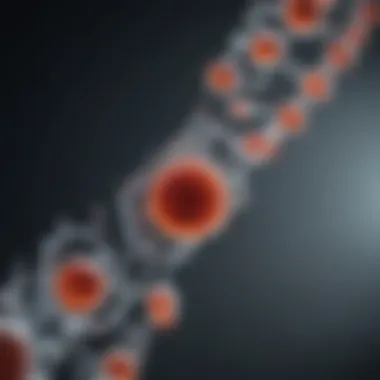Exploring Dynabeads mRNA: Insights and Innovations


Intro
The world of molecular biology continues to deepen its complexity and sophistication, yet among the instrumental tools that aid this journey, Dynabeads mRNA technology stands out prominently. This technique doesn’t just represent a mechanism for isolation and purification of messenger RNA (mRNA); it epitomizes a pivotal shift in how researchers approach their experimental designs, moving towards more refined and efficient methods. As this article unfolds, readers will be taken through a detailed exploration of Dynabeads mRNA, its mechanisms, applications, and future prospects.
Research Context
Background and Rationale
The proliferation of mRNA applications—most notably in vaccine development and gene therapy—has resulted in an urgent demand for high-quality mRNA isolation techniques. Traditional methods often fall short in terms of sensitivity and specificity, propelling the adoption of innovative solutions, such as Dynabeads. These unique magnetic beads, coated with specific oligonucleotides, facilitate a streamlined approach to mRNA isolation, which is foundational for accurate downstream analyses. The rationale behind utilizing Dynabeads mRNA lies in its simplicity and effectiveness, providing researchers a pathway to not just meet, but exceed the rigors of modern applications in both academic and clinical settings.
Literature Review
Numerous studies have illuminated the capabilities of Dynabeads mRNA. For instance, research has shown their utility in enhancing RNA-seq library preparation by ensuring higher yields and quality of isolated mRNA. A systematic review highlights the adaptability of this technology across diverse biological samples, from cultured cells to clinical tissues.
Some notable studies indicate that employing Dynabeads significantly circumvents the common challenges faced when relying on classical extraction methods. Particularly, their reproducibility in isolating low-abundance mRNAs greatly supports applications in differential gene expression analysis. Moreover, as noted by several experts in the field, the fine-tuning of bead characteristics and functionalization opens up avenues for tailored applications in gene delivery systems and diagnostics.
"The use of Dynabeads mRNA technology signals a new era for researchers aiming to unlock the potential of mRNA in therapeutic contexts." - A prominent molecular biologist.
The breadth of research surrounding this topic makes for a compelling case, as both foundational and cutting-edge applications converge in the realm of Dynabeads mRNA technology.
Methodology
Research Design
A mixed-methods approach can offer a comprehensive view of current understandings and applications of Dynabeads mRNA. Through qualitative analyses of existing literature alongside quantitative lab experiments measuring efficiency, researchers can establish a robust narrative of its effectiveness across varied contexts.
Data Collection Methods
Data gathering can incorporate both primary and secondary sources. Primary data can include experimental results from laboratories utilizing Dynabeads for mRNA isolation, while secondary sources encompass previous research papers and reviews available in scientific databases like PubMed and institutional repositories. Furthermore, online forums such as reddit.com can provide anecdotal insights from users, highlighting practical experiences and challenges encountered in real-world applications.
Prelude to Dynabeads mRNA Technology
In the arena of molecular biology, the ability to isolate and purify mRNA has become a cornerstone for a multitude of research applications. Dynabeads mRNA technology serves as a pivotal tool, delivering precision and efficiency in mRNA extraction. This segment looks to illuminate the fundamental aspects of this technology while underscoring its significance in both academic and clinical settings.
A key aspect of Dynabeads mRNA technology is its robust ability to aid researchers in navigating the complexities of gene expression studies and therapeutic developments. With the growing interest in mRNA-based vaccines and therapies, understanding its operational mechanisms is essential. This section will delve into not only the historical context and foundational principles of the technology but also clarify what exactly makes Dynabeads a favorite in laboratories worldwide.
Historical Context and Development
The journey of Dynabeads mRNA traces back to the foundational advancements in magnetic bead technology. Initially developed in the 1980s, these beads became a game-changer, allowing for efficient biological separations. The invention of Dynabeads was an undertaking that promised a way to streamline the laborious processes inherent to mRNA purification. Research labs around the globe began adopting these innovations, paving the way for newer applications in both academic experiments and therapeutic research. This historical evolution reflects a continuous loop of feedback between technological advancements and scientific growth, ultimately enhancing reliability and productivity in laboratories.
What are Dynabeads?
Dynabeads are not just any ordinary beads; they are specifically engineered magnetic particles that come coated with specific capture molecules tailored to bind to target molecules, such as mRNA. These tiny beads allow for the selective isolation of mRNA from complex biological samples.
The inherent design of Dynabeads maximizes their binding capacity, enabling a high degree of specificity that is essential for achieving accurate results. Unlike traditional purification methods, which can be hit-or-miss, Dynabeads simplify the entire process. Researchers can resuspend the beads in their solution, apply a magnetic field, and voila—the desired mRNA is retained on the beads while other components are washed away.
One of the astonishing features of Dynabeads is their adaptability. They can be employed in various molecular techniques, including reverse transcription PCR and library preparation for sequencing, making them a versatile tool in the hands of scientists. The ease of use and effectiveness of Dynabeads make them invaluable—not merely as a laboratory aid but as a catalyst for innovation in large-scale mRNA applications.
"With the help of Dynabeads, we are not just furthering scientific knowledge; we are also expanding the horizons of what is possible in medical research and treatment."


Understanding the Mechanism of Action
Recognizing the underlying mechanisms of how Dynabeads mRNA operate is essential for grasping their practical applications and overall significance in molecular biology. Understanding the mechanism not only sheds light on how these beads function, but it also emphasizes the innovative approach to mRNA isolation and purification. This section delves into the intricacies of magnetic bead technology and the processes involved in isolating and purifying mRNA, highlighting their advantages and addressing considerations relevant to researchers.
Magnetic Bead Technology Explained
Magnetic beads are small, often ranging from 1 to 10 micrometers in diameter, and are coated with a surface that allows specific interactions with target molecules, such as mRNA. These beads utilize a magnetic force for manipulation, making the isolation of biomolecules efficient and straightforward. When they are placed in a solution that contains the target mRNA, the beads take hold of the molecules, enabling researchers to separate them from contaminants through the application of an external magnetic field.
This technology marks a significant shift from more traditional methods like centrifugation or precipitation. The beauty of using magnetic beads lies in their ability to streamline the isolation process. Instead of multiple steps that consume time and resources, magnetic bead separation simplifies harvesting the desired mRNA in a single, efficient step. Moreover, the ability to fine-tune bead surface properties allows for high specificity in binding, which enhances the purity of the isolated material.
Isolation and Purification Process
The isolation and purification process using Dynabeads mRNA involves systematic steps that leverage the unique qualities of these magnetic tools. After the sample preparation, the beads are introduced, facilitating the binding of desired mRNA molecules.
Binding Affinity and Specificity
Binding affinity refers to the strength of the interaction between the mRNA and the Dynabeads. A high binding affinity is critical for successful isolation, as it ensures that most, if not all, the target molecules will stick to the beads. This reduces the likelihood of losing valuable samples during the washing steps.
One key characteristic of binding affinity is the specific interactions that can be achieved through functionalized surfaces on the beads. For instance, if the Dynabeads are designed to target specific sequences in the mRNA, they will selectively bind only to those sequences. This attribute makes Dynabeads a preferred option compared to other isolation techniques, which may inadvertently capture non-target molecules.
However, while a strong binding affinity is beneficial, there can be drawbacks. If the affinity is too strong, it may be challenging to elute the mRNA in good yield without damaging the molecules. Researchers must strike a balance between binding strength and elution efficiency to optimize the isolation process.
Recovery and Elution Techniques
Recovery and elution techniques play a pivotal role in ensuring that the isolated mRNA is obtained in a form suitable for downstream applications. After binding, the next step involves the careful washing away of non-target materials, followed by the elution of the bound mRNA.
A key feature of recovery techniques involves the choice of buffers and the conditions under which elution occurs. Using gentle elution conditions can help maximize yield while maintaining the integrity of the mRNA. This is particularly important for sensitive applications like quantitative PCR or RNA sequencing, where the quality of the starting material directly influences the results.
The distinct advantage of recovery and elution techniques is their adaptability. Different types of elution methods can be employed, such as changing salt concentrations or using competing oligonucleotides to facilitate the release of mRNA. However, researchers need to be mindful of the unique combination of factors, as inappropriate elution conditions might lead to degradation or loss of target RNA.
"Harnessing the efficiency of magnetic bead technology transforms the landscape of mRNA research, propelling us forward into an era of greater precision and reliability in molecular biology."
Applications in Research
Understanding the vast landscape of applications for Dynabeads mRNA technology is imperative for both budding and seasoned researchers. As a versatile tool, it holds significant relevance across various facets of molecular biology. The capacity of Dynabeads to isolate and purify mRNA empowers scientists to delve deeper into gene expression and protein studies, ultimately pushing the boundaries of biological research.
In this section, we explore how Dynabeads mRNA serves not only as a facilitator of experimentation but also as a catalyst for breakthroughs in scientific understanding. Its unique properties offer several advantages, such as improved specificity and recovery rates, setting the stage for innovative approaches to data interpretation and analysis.
Gene Expression Studies
Real-Time PCR Applications
Real-time PCR has revolutionized the field of gene expression studies, and the incorporation of Dynabeads mRNA elevates it even further. One of the standout aspects of this method is its ability to provide instantaneous feedback on the quantity of mRNA present during amplification. This real-time data proves invaluable for researchers focusing on dynamic gene expression, especially in time-sensitive experiments.
The reliance on Dynabeads mRNA in real-time PCR stems from its notable binding efficiency. These beads bind mRNA effectively, ensuring a clean extraction that enhances the reliability of downstream applications. A unique feature of real-time PCR is the use of fluorescent dyes, which allow for the visualization of results as they occur. This immediacy presents a significant advantage in studies that are monitoring gene expression under varying conditions.
However, it’s crucial to acknowledge that the specificity of real-time PCR can be influenced by several variables, including primer design and the presence of inhibitors. While Dynabeads mRNA mitigates some concerns related to extraction efficiency, researchers must remain vigilant about other factors that could affect their outcomes.
RNA Sequencing Preparation
When it comes to RNA sequencing preparation, the impact of Dynabeads mRNA is twofold. On one hand, it streamlines the extraction process; on the other, it significantly enhances the quality of the RNA that researchers ultimately yield. Herein lies a critical aspect of sequencing: the necessity for high-quality mRNA to achieve accurate and meaningful results.


The key characteristic that sets Dynabeads mRNA apart in the context of RNA sequencing is its high binding capacity, which ensures maximum retention of target mRNA during purification. This is particularly beneficial as it reduces the background noise often associated with RNA sequencing data, thus allowing for clearer and more interpretable results.
An additional advantage of utilizing Dynabeads mRNA for RNA sequencing is the scalability it offers. Whether the goal is a small batch for preliminary analyses or a larger sample for comprehensive studies, the beads adapt well to both scenarios. Nevertheless, this method requires meticulous handling during the extraction phase, as any mishap in processing could lead to significant variations in sequencing results.
Protein Expression and Analysis
Western Blotting Enhancements
Western blotting has long been a staple technique for protein analysis. With Dynabeads mRNA, researchers can enhance their western blotting protocols significantly. The integration of these beads aids in the purification and concentration of mRNA, thereby improving the yield of target proteins. The benefit here is clear: by ensuring that more relevant mRNA is available for translation, researchers can obtain a more accurate representation of protein expression.
A noteworthy characteristic of this enhancement is the reduction in background signal that can often plague Western blots. Since Dynabeads facilitate a cleaner pull-down during the extraction phase, the result is clearer bands, making it easier to interpret findings. However, researchers must be mindful of the potential for non-specific binding when using beads, which could complicate results if not addressed properly.
Functional Studies
Functional studies elevate the research landscape by bridging mRNA expression and the resultant biological outcomes. The application of Dynabeads mRNA in this realm ensures that researchers have access to pure mRNA for functional assays, drastically improving the reliability of their findings.
The unique feature of using Dynabeads for functional studies is the seamless transition from mRNA isolation to functional analysis. This integration not only saves time but also minimizes the risk of degradation that can occur during multiple processing steps. An advantage of this approach is the amplification of insights into cellular mechanisms that can often remain obscured in less targeted methodologies. Still, as with any methodological integration, attention to detail during sample handling is essential to avoid skewing conclusions.
Clinical Applications and Therapeutic Implications
Clinical applications of Dynabeads mRNA technology are expanding at a remarkable rate. This section examines how Dynabeads are revolutionizing the landscape of vaccine research and genetic therapies, highlighting the implications this has on modern medicine.
Role in Vaccine Research
Innovations in mRNA Vaccine Technology
A crucial area where Dynabeads mRNA technology shines is in vaccine research. The pioneering innovations in mRNA vaccine design are reshaping the way we think about immunization. One key characteristic of this innovation is efficiency; using Dynabeads allows research teams to streamline the process of isolating and purifying mRNA. This facilitates faster development cycles for vaccines, especially important during health crises.
The unique feature of these innovations involves their adaptability. mRNA vaccines can be quickly modified to respond to emerging pathogens, which has become a focal point for public health. The advantages are considerable, such as shorter development times and potential for high efficacy. However, there are challenges; storage conditions must be carefully managed to ensure the stability of the mRNA. This aspect of mRNA vaccine technology illustrates the dynamic nature of research and development facilitated by Dynabeads.
Evaluation of Immune Response
Evaluating immune responses is another integral part of vaccine research. The use of Dynabeads in assessing how well an immune system reacts to mRNA vaccines provides critical data for efficacy studies. One of the standout characteristics here is the capability to analyze various immunogenic markers, which can predict vaccine success.
The unique aspect of this evaluation process is the precision it brings. By utilizing Dynabeads, researchers can isolate specific immune cells and gauge their response to antigens presented by the vaccine. This precision aids in tailoring future vaccine formulations, making them more effective. While there are numerous benefits, such as enhanced monitoring of immune responses, the challenges include the need for extensive data analysis and interpretation to truly understand the outcomes.
Applications in Genetic Therapies
Delivering Therapeutic mRNA
Dynabeads play a pivotal role in delivering therapeutic mRNA, which is rapidly evolving as a treatment strategy for various diseases. A central characteristic of this application is the targeted delivery system that Dynabeads enable. This targeted approach enhances the effectiveness of mRNA therapies by ensuring that therapeutic agents reach the intended cells without off-target effects.
The distinctive feature of delivering therapeutic mRNA using Dynabeads is their ability to protect the mRNA until it is delivered inside the cell. This can significantly improve the mRNA's activity in the cell. The advantages are evident in terms of increased efficiency and safety, although one must consider the hurdles of regulatory approval and long-term outcomes in patients.
Addressing Genetic Disorders
Finally, addressing genetic disorders through Dynabeads is promising and emerging field. The technology allows for more precise interventions, targeting specific genetic mutations effectively. One key characteristic that stands out is the ability to achieve high specificity in targeting—and potentially correcting—defective genes.
A unique feature of using Dynabeads in this context is the modularity of the approach, providing flexibility in designing gene therapies tailored to individual patients. The benefits here are profound, as personalized treatments could drastically improve the quality of life for those affected by genetic disorders. However, issues such as ethical considerations and patient consent remain complex topics needing thorough discussion.
"The application of Dynabeads mRNA technology is paving the way for breakthroughs in therapeutic avenues that were once considered science fiction."


Future Directions in Dynabeads mRNA Research
The landscape of research in Dynabeads mRNA technology is ever-evolving, highlighting the increasing relevance of this topic in molecular biology and biotechnology. As scientists delve deeper into the mechanisms and applications of Dynabeads, the future directions of this research hold promise for enhanced efficiency and accessibility. These advancements are crucial for scientists looking to streamline workflows, improve which experimental outcomes, and ultimately widen the scope of applications in both clinical and research environments.
Advancements in Bead Design
Targeting Efficiency Improvements
One pivotal aspect of future developments is the enhancement of targeting efficiency in Dynabeads mRNA technology. Targeting efficiency directly impacts the precision with which mRNA is isolated and purified, affecting the fidelity of downstream applications, which can include everything from gene editing to vaccine development.
A key characteristic of improved targeting efficiency is the ability to customize the surface properties of the beads, allowing for better binding affinity to specific mRNA sequences. This tailored approach not only enhances selectivity but also ensures that the yield of the desired mRNA is maximized, reducing wasted resources. The unique feature of this customization is that it results in higher overall performance, making it a popular choice in the field.
However, while this approach has distinct advantages—such as better specificity and yields—it can present challenges too. For instance, the additional engineering involved can elevate costs or complicate the production process. Yet, the benefits outweigh these drawbacks, as enhanced targeting efficiencies drive progress in experimental science.
Scalability and Mass Production
Another vital area of progress is the scalability and mass production of Dynabeads. As demand for mRNA applications grows, the need for methods that allow for cost-effective and large-scale production becomes essential. This aspect taps into the very core of biotechnology—being able to produce sufficient material for widespread use.
A significant feature of scalable production is that it facilitates uniformity in bead quality, which is essential. Without consistency, the results of experiments can vary significantly, leading to unreliable data. Furthermore, cost-efficient production techniques can lower barriers to entry for research institutions and laboratories with limited resources.
That said, the journey towards perfecting large-scale production is not without its hurdles. The integration of advanced manufacturing techniques can introduce complexities. Yet, navigating these challenges is critical, as mass production represents a necessary development in democratizing access to cutting-edge mRNA technology.
Integration with Nanotechnology
The convergence of Dynabeads mRNA technology with nanotechnology is surfacing as a promising frontier. Nanotechnology offers the ability to manipulate materials at the molecular level, paving the way for innovations that significantly elevate the capabilities of Dynabeads. By incorporating nanoscale elements, researchers can explore enhanced binding interactions and targeted delivery systems, potentially revolutionizing how therapeutics are conceived and deployed. This integration could lead to novel applications in areas such as precision medicine and targeted gene therapy, where efficacy and specificity are paramount.
Ethical Considerations and Regulatory Challenges
As Dynabeads mRNA technologies advance, they also raise ethical considerations and regulatory challenges that warrant urgent attention. The implications of enhanced mRNA usage in research and therapeutics touch on a range of ethical dilemmas, including issues of consent, ownership of genetic material, and the potential for unintended consequences in gene editing. Navigating the regulatory landscape is becoming increasingly complex, particularly as novel applications come to the forefront.
Researchers must continually assess the ethical ramifications of their work, ensuring that advancements do not outpace the frameworks designed to safeguard public health and welfare. Engaging in open dialogue with policymakers, ethicists, and the public can foster a more balanced approach to the ongoing evolution of Dynabeads mRNA technology.
"Future directions in Dynabeads mRNA research not only buttress the technological advancements that lie ahead but also guide the ethical compass that will steer innovation in life sciences."
In summary, the future directions in Dynabeads mRNA research carry immense potential. With ongoing advancements in bead design, integration with nanotechnology, and robust ethical discussions, the evolving landscape promises to pave the way for revolutionary discoveries that extend the frontiers of biotechnology.
The End
In this exploration of Dynabeads mRNA technology, we've uncovered not just the nuts and bolts of how it works, but also the profound impact it has across various scientific landscapes. This conclusion serves as a pivotal summarization, threading together the intricate details and significant observations we've discussed in prior sections. Understanding both the merits and limitations of Dynabeads mRNA enhances the conversation about its application and potential, offering a holistic view of its current state and future possibilities.
Summary of Key Insights
Reflecting on our traversal through Dynabeads mRNA technology, several key insights emerge as both fundamental and enlightening:
- Versatile Applications: The use of Dynabeads mRNA spans from basic gene expression studies to groundbreaking vaccine research, showcasing its adaptability in diverse research environments.
- Scientific Advancements: With continuous improvements in bead design and the integration of nanotechnology, Dynabeads are on the leading edge of innovative methodologies in molecular biology.
- Regulatory and Ethical Dimensions: The challenges surrounding the ethical considerations and regulatory frameworks for using Dynabeads mRNA remind us that scientific progress must balance innovation with responsibility.
“Scientific advancement isn’t just about discovery; it’s about application, ethics, and future potential.”
These insights not only reflect the capabilities of Dynabeads mRNA but also signal an encouraging trajectory for ongoing research in the life sciences.
Final Thoughts on the Impact of Dynabeads mRNA
The advent of Dynabeads mRNA has ushered in a new era in biotechnology, with its ramifications touching nearly every facet of molecular biology. Its pivotal role in facilitating the isolation and purification of mRNA streamlines numerous laboratory processes, enhancing accuracy and efficiency. As we gaze into the horizon of future possibilities, it is clear that Dynabeads will continue to inspire and enable innovations that could very well redefine therapeutic approaches and research methodologies.
The future shines bright for Dynabeads mRNA, and staying abreast of its developments is essential. Researchers and professionals alike must keep an eagle eye on how these technologies evolve and how they could possibly transform the tapestry of biomedical science.
Overall, the implications of Dynabeads mRNA are both broad and deep, signaling a profound shift in how we view and utilize genetic materials in contemporary science.



